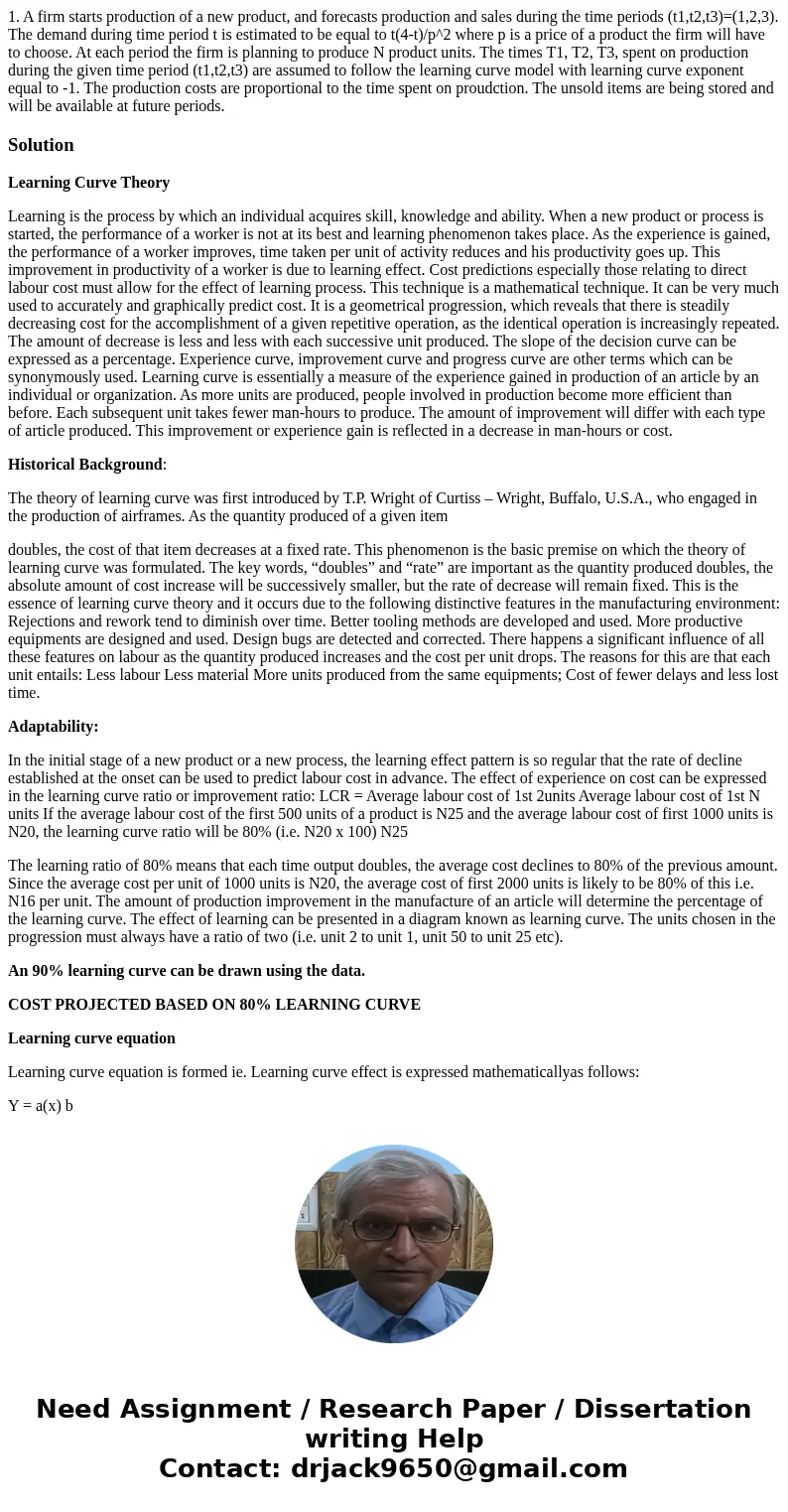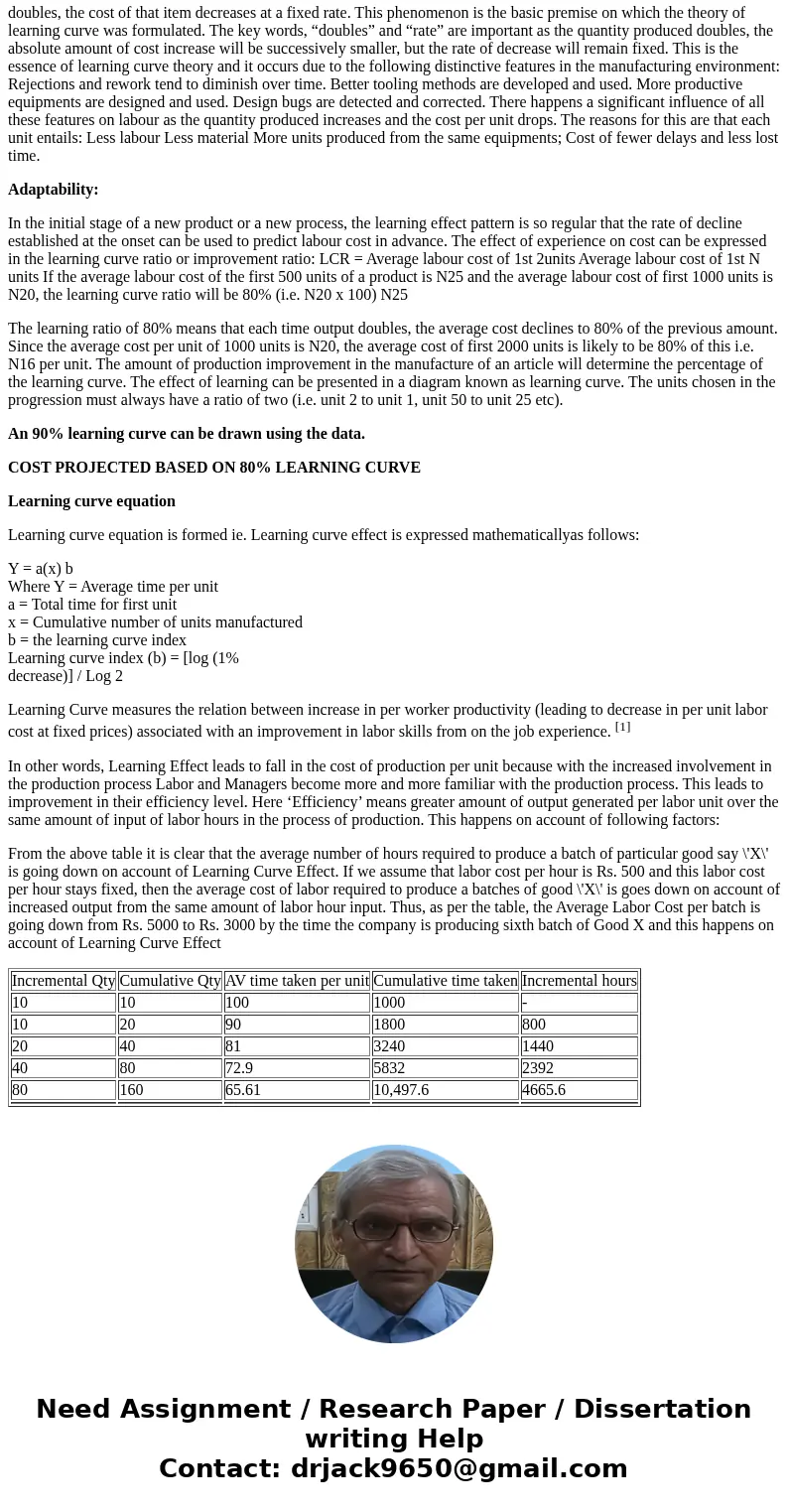1 A firm starts production of a new product and forecasts pr
1. A firm starts production of a new product, and forecasts production and sales during the time periods (t1,t2,t3)=(1,2,3). The demand during time period t is estimated to be equal to t(4-t)/p^2 where p is a price of a product the firm will have to choose. At each period the firm is planning to produce N product units. The times T1, T2, T3, spent on production during the given time period (t1,t2,t3) are assumed to follow the learning curve model with learning curve exponent equal to -1. The production costs are proportional to the time spent on proudction. The unsold items are being stored and will be available at future periods.
Solution
Learning Curve Theory
Learning is the process by which an individual acquires skill, knowledge and ability. When a new product or process is started, the performance of a worker is not at its best and learning phenomenon takes place. As the experience is gained, the performance of a worker improves, time taken per unit of activity reduces and his productivity goes up. This improvement in productivity of a worker is due to learning effect. Cost predictions especially those relating to direct labour cost must allow for the effect of learning process. This technique is a mathematical technique. It can be very much used to accurately and graphically predict cost. It is a geometrical progression, which reveals that there is steadily decreasing cost for the accomplishment of a given repetitive operation, as the identical operation is increasingly repeated. The amount of decrease is less and less with each successive unit produced. The slope of the decision curve can be expressed as a percentage. Experience curve, improvement curve and progress curve are other terms which can be synonymously used. Learning curve is essentially a measure of the experience gained in production of an article by an individual or organization. As more units are produced, people involved in production become more efficient than before. Each subsequent unit takes fewer man-hours to produce. The amount of improvement will differ with each type of article produced. This improvement or experience gain is reflected in a decrease in man-hours or cost.
Historical Background:
The theory of learning curve was first introduced by T.P. Wright of Curtiss – Wright, Buffalo, U.S.A., who engaged in the production of airframes. As the quantity produced of a given item
doubles, the cost of that item decreases at a fixed rate. This phenomenon is the basic premise on which the theory of learning curve was formulated. The key words, “doubles” and “rate” are important as the quantity produced doubles, the absolute amount of cost increase will be successively smaller, but the rate of decrease will remain fixed. This is the essence of learning curve theory and it occurs due to the following distinctive features in the manufacturing environment: Rejections and rework tend to diminish over time. Better tooling methods are developed and used. More productive equipments are designed and used. Design bugs are detected and corrected. There happens a significant influence of all these features on labour as the quantity produced increases and the cost per unit drops. The reasons for this are that each unit entails: Less labour Less material More units produced from the same equipments; Cost of fewer delays and less lost time.
Adaptability:
In the initial stage of a new product or a new process, the learning effect pattern is so regular that the rate of decline established at the onset can be used to predict labour cost in advance. The effect of experience on cost can be expressed in the learning curve ratio or improvement ratio: LCR = Average labour cost of 1st 2units Average labour cost of 1st N units If the average labour cost of the first 500 units of a product is N25 and the average labour cost of first 1000 units is N20, the learning curve ratio will be 80% (i.e. N20 x 100) N25
The learning ratio of 80% means that each time output doubles, the average cost declines to 80% of the previous amount. Since the average cost per unit of 1000 units is N20, the average cost of first 2000 units is likely to be 80% of this i.e. N16 per unit. The amount of production improvement in the manufacture of an article will determine the percentage of the learning curve. The effect of learning can be presented in a diagram known as learning curve. The units chosen in the progression must always have a ratio of two (i.e. unit 2 to unit 1, unit 50 to unit 25 etc).
An 90% learning curve can be drawn using the data.
COST PROJECTED BASED ON 80% LEARNING CURVE
Learning curve equation
Learning curve equation is formed ie. Learning curve effect is expressed mathematicallyas follows:
Y = a(x) b
Where Y = Average time per unit
a = Total time for first unit
x = Cumulative number of units manufactured
b = the learning curve index
Learning curve index (b) = [log (1%
decrease)] / Log 2
Learning Curve measures the relation between increase in per worker productivity (leading to decrease in per unit labor cost at fixed prices) associated with an improvement in labor skills from on the job experience. [1]
In other words, Learning Effect leads to fall in the cost of production per unit because with the increased involvement in the production process Labor and Managers become more and more familiar with the production process. This leads to improvement in their efficiency level. Here ‘Efficiency’ means greater amount of output generated per labor unit over the same amount of input of labor hours in the process of production. This happens on account of following factors:
From the above table it is clear that the average number of hours required to produce a batch of particular good say \'X\' is going down on account of Learning Curve Effect. If we assume that labor cost per hour is Rs. 500 and this labor cost per hour stays fixed, then the average cost of labor required to produce a batches of good \'X\' is goes down on account of increased output from the same amount of labor hour input. Thus, as per the table, the Average Labor Cost per batch is going down from Rs. 5000 to Rs. 3000 by the time the company is producing sixth batch of Good X and this happens on account of Learning Curve Effect
| Incremental Qty | Cumulative Qty | AV time taken per unit | Cumulative time taken | Incremental hours |
| 10 | 10 | 100 | 1000 | - |
| 10 | 20 | 90 | 1800 | 800 |
| 20 | 40 | 81 | 3240 | 1440 |
| 40 | 80 | 72.9 | 5832 | 2392 |
| 80 | 160 | 65.61 | 10,497.6 | 4665.6 |


 Homework Sourse
Homework Sourse